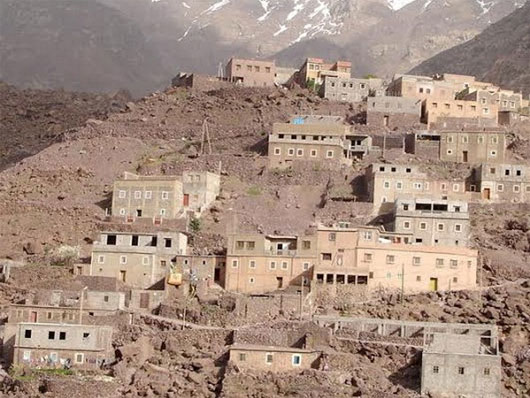Decode the source of giant pebbles in Morocco
The origin of a giant pile of pebbles in Morocco, where a small, staggering little village, has long been a mystery to scientists.
But so far, the mystery has been solved: this pile of stones is the result of a horrific mountain eruption that occurred 4,500 years ago on the high mountains of the Atlas range.
Scientists analyzed what remains of one of the largest ruins in North America, the Arroumd landslide in the northwest at the foot of Aksoual mountain, a mountain of 3,912m above sea level in the region. High mountain on Atlas range in Morocco.
A village is currently located on the top of a rocky beach with a height of about 2,000m.
Arroumd's origins and chronology have led scientists to headaches for more than 135 years. Previously, researchers believed that the pile was part of the ice-ice and sediment of the glacier.
In contrast, the lead author of the study Philip Hughes, a geologist at the University of Manchester (UK), hypothesized that Arroumd was the result of a rock fall that occurred after the glacier passed through the valley. here melt.

The rocky village of Arroumd falls on the Atlas range in Morocco.(Photo: livescience.com)
To decipher the mystery of Arroumd, Hughes and his colleagues dated the stones here. They examined the isotope content of beryllium-10, a substance normally produced when rays from the universe impact quartz on the rock surface.
Isotope content will indicate when the rocks come into contact with the air, as well as when the sediment is formed.
The results of the test were unexpected: the rock fall occurred after the glacier melted.
'The glacier melted 11,700 years ago at the end of the last ice age. However, the cliffs only collapsed from 4,500 years ago, so it is not caused by melting glaciers but falling rocks. "
Instead, scientists suspected of a rock fall due to geological activities are located very close to an area where tectonic activities occur.
'I did not expect that the landslide happened so late. But I am always ready to challenge and look back, and hope to improve my previous research. That's what science is, " Hughes said.
The erosion caused by glaciers may have caused the cliffs to be steeper, allowing the rock to roll down.'It is possible that the valleys that once had glaciers will fall down due to an earthquake, a heavy rain, or both. In the European Alps, there is evidence that there was also a series of similar mountain landslides at the same time, and a recent study also pointed out that an avalanche was caused by an extremely heavy rain that occurred in " Hughes added.
Arroumd is a difficult place to work, Hughes said.'There have been a few minor accidents in the study area, and some people have come there too mysteriously. I often joke with people about a "curse" in Arroumd. This year we encountered a few whirlwinds when we entered the valley, just a few days after the study was published. We cannot stand because the wind is so strong, it is very unusual because the area is a warm and mild climate. '
- Evidence of water once flowing on Mars
- What shaped pebbles?
- Goat climbing in Morocco
- Sun planes delayed flying to Morocco
- Found the most giant fossil lobster on earth 480 million years ago
- Discover the oldest seashell jewelry in Morocco
- Morocco: 'Mini fridge' for quantum computers
- Morocco will produce electricity from solar energy
- The two-headed calf was born in Morocco
- Decode the mystery of ancient Roman architecture
- Anonymous beaches in Japan became famous for using recycled materials
- The air shot when the star 'gave birth'
 'Fine laughs' - Scary and painful torture in ancient times
'Fine laughs' - Scary and painful torture in ancient times The sequence of numbers 142857 of the Egyptian pyramids is known as the strangest number in the world - Why?
The sequence of numbers 142857 of the Egyptian pyramids is known as the strangest number in the world - Why? History of the iron
History of the iron What is alum?
What is alum?